After yesterday’s post featuring mating Red-tailed Hawks, today’s edition tells “the rest of the story”.
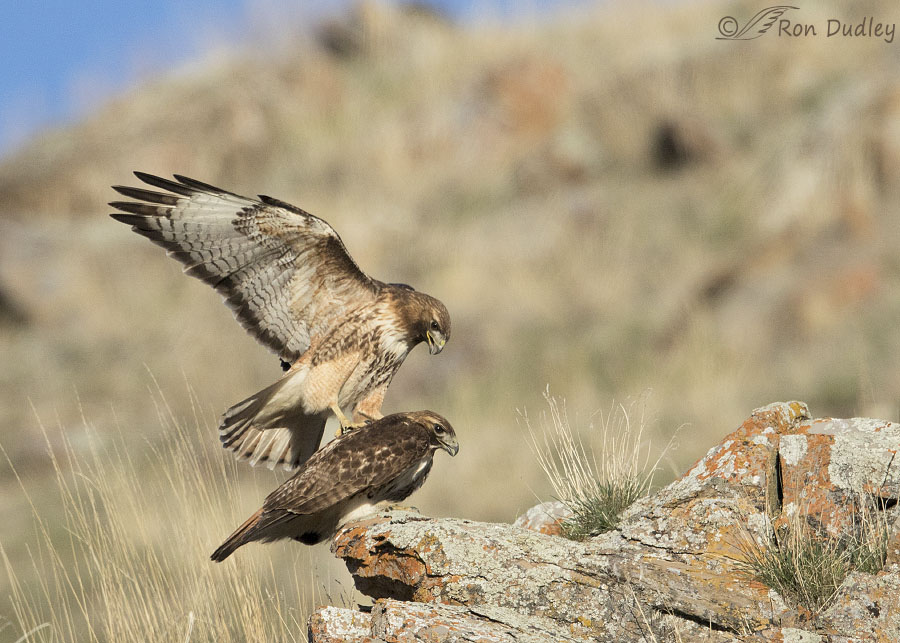
1/5000, f/6.3, ISO 800, Canon 7D Mark II, Canon EF 500mm f/4L IS II USM + EF 1.4 III Extender, not baited, set up or called in
But first let’s pick up from about where we left yesterday with the hawks mating on this rocky outcrop some distance from their nest (I didn’t include this image in yesterday’s post). After their mating session was concluded I mentioned that the male “flew off to contribute even more efforts to their nesting activities” which is exactly what I’ll be documenting today. During the entire time that follows the female remained perched on these rocks and observed the tireless (and tiring) efforts of her mate.
Some of the following photos are only of marginal quality but my purpose here is to document the behavior of the male so I’m not particularly concerned about image quality. All photos are presented in the order they were taken.
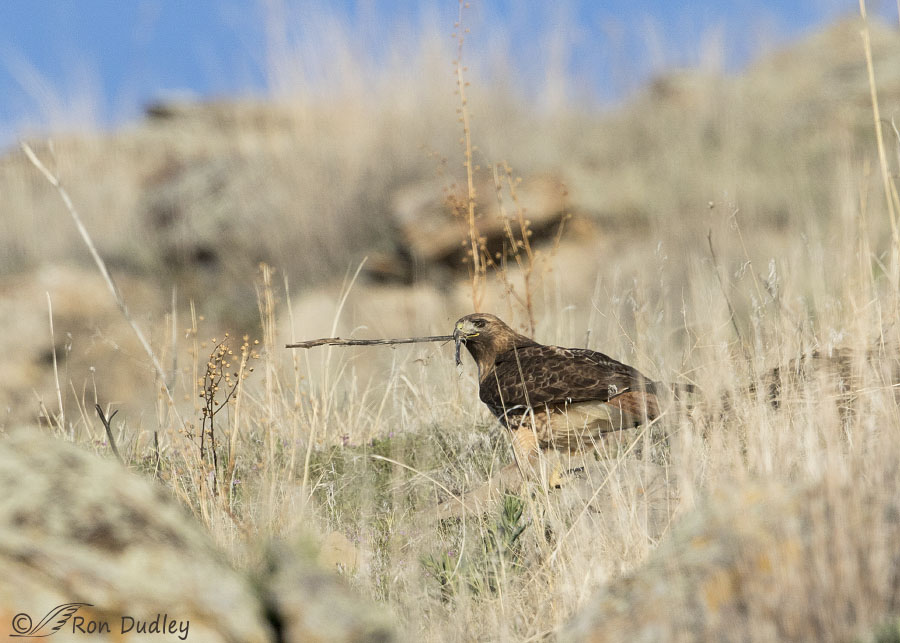
1/3200, f/7.1, ISO 640, Canon 7D Mark II, Canon EF 500mm f/4L IS II USM + EF 1.4 III Extender, not baited, set up or called in
After the male left the female he almost immediately began an extended period of nest-building. He repeatedly flew onto or just behind a nearby hill to gather sticks, twigs and grasses and then carried them to the nest. I often couldn’t see him clearly or at all while he was on the ground so…
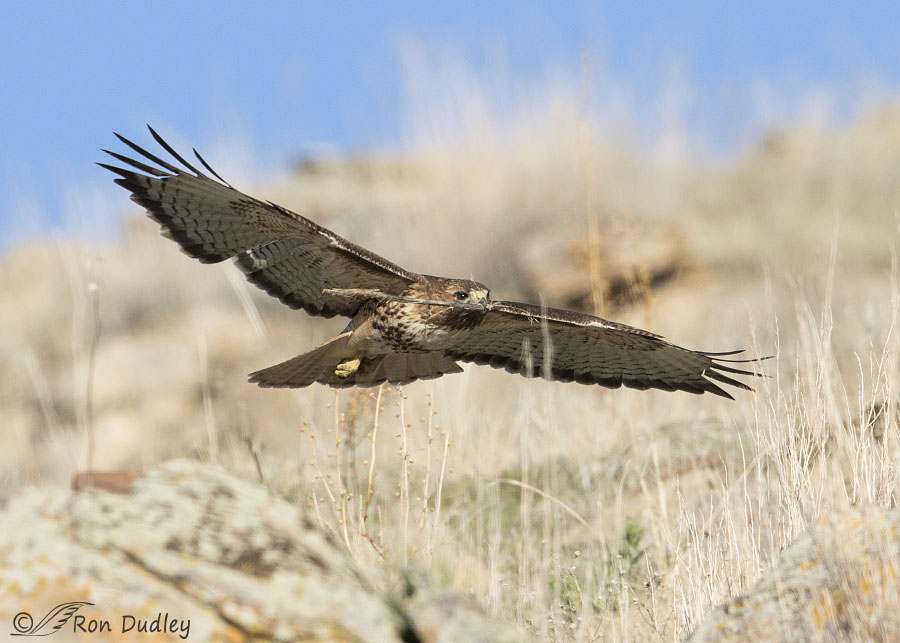
1/2000, f/7.1, ISO 640, Canon 7D Mark II, Canon EF 500mm f/4L IS II USM + EF 1.4 III Extender, not baited, set up or called in
my best chances of photographing him with nesting material were while he was in flight and on his way to the nest. This was the first stick he picked up after the mating.
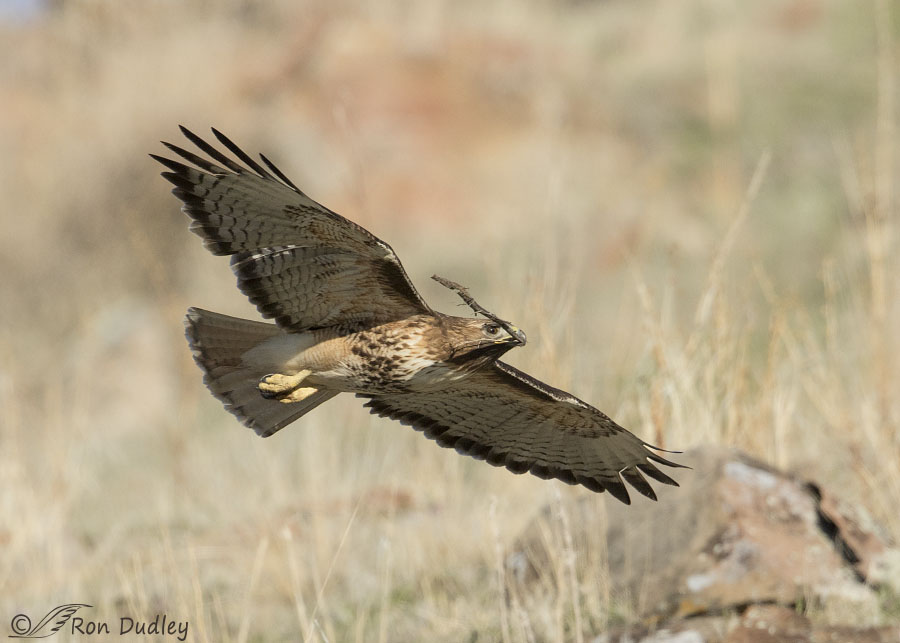
1/2500, f/7.1, ISO 640, Canon 7D Mark II, Canon EF 500mm f/4L IS II USM + EF 1.4 III Extender, not baited, set up or called in
Six frames later he passed closer between me and the hillside. I nearly always prefer backgrounds other than homogenous sky so most of the photos I’ve chosen to present have the hill in the background but that presents its own problems. With the background so close to the hawk its quite difficult to keep sharp focus on a bird in flight but I thought this one was sharp enough.
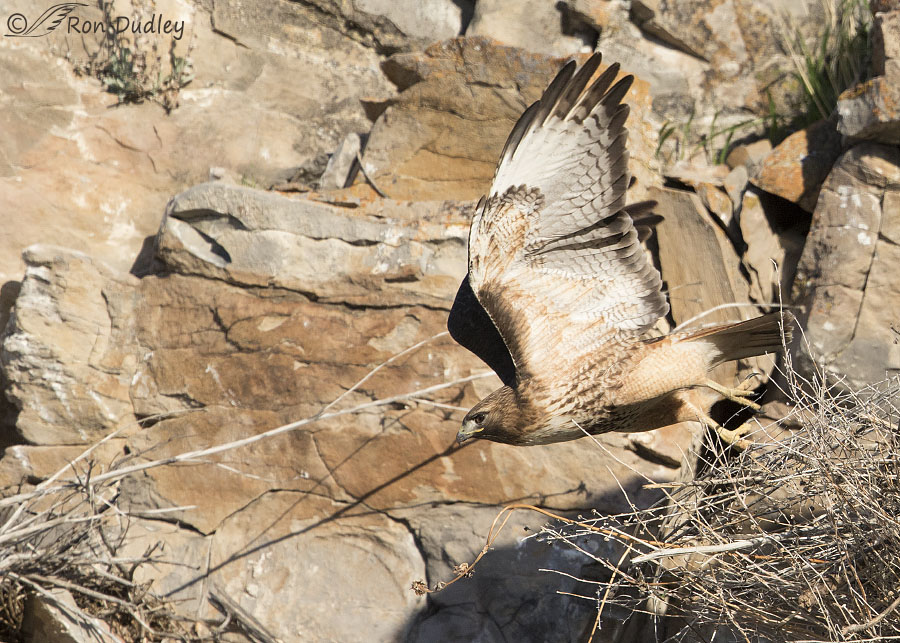
1/2000, f/7.1, ISO 640, Canon 7D Mark II, Canon EF 500mm f/4L IS II USM + EF 1.4 III Extender, not baited, set up or called in
He quickly arranged the stick on the nest (most of which I cannot see well) and took off for more nesting material.
- I want to stress that I wasn’t close to the nest. With my gear I’m shooting at an effective 1120mm and these images have been cropped significantly. As always I was shooting from the road and inside my pickup and I never even cracked open the door. These hawks are acclimated to the presence of vehicles on the road but if I’d have impacted their behavior or disturbed the birds in any way I’d have left the area immediately.
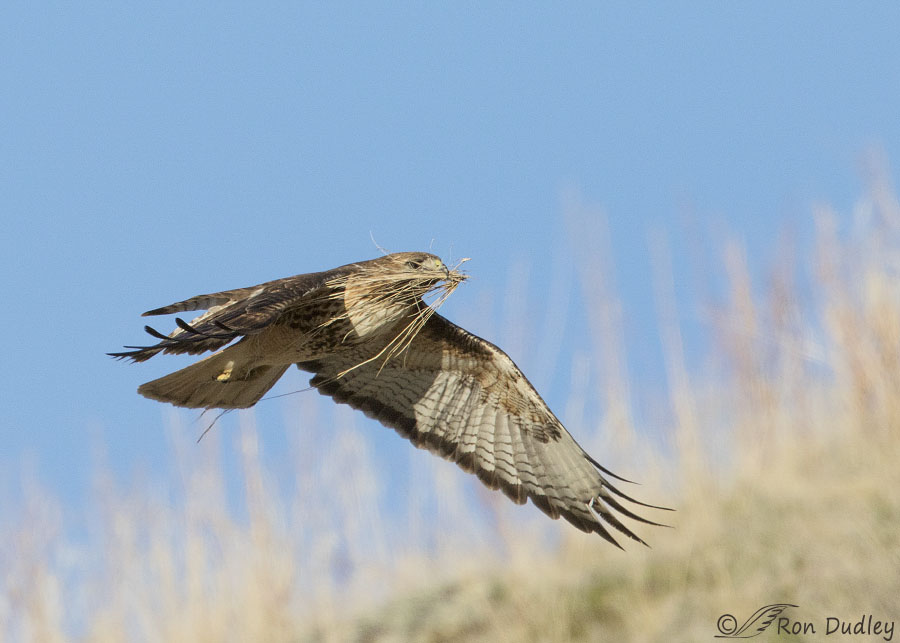
1/4000, f/7.1, ISO 640, Canon 7D Mark II, Canon EF 500mm f/4L IS II USM + EF 1.4 III Extender, not baited, set up or called in
Less than 2 minutes later his nesting material of choice was a clump of dried vegetation. This time the hill in the background was mostly below him so…
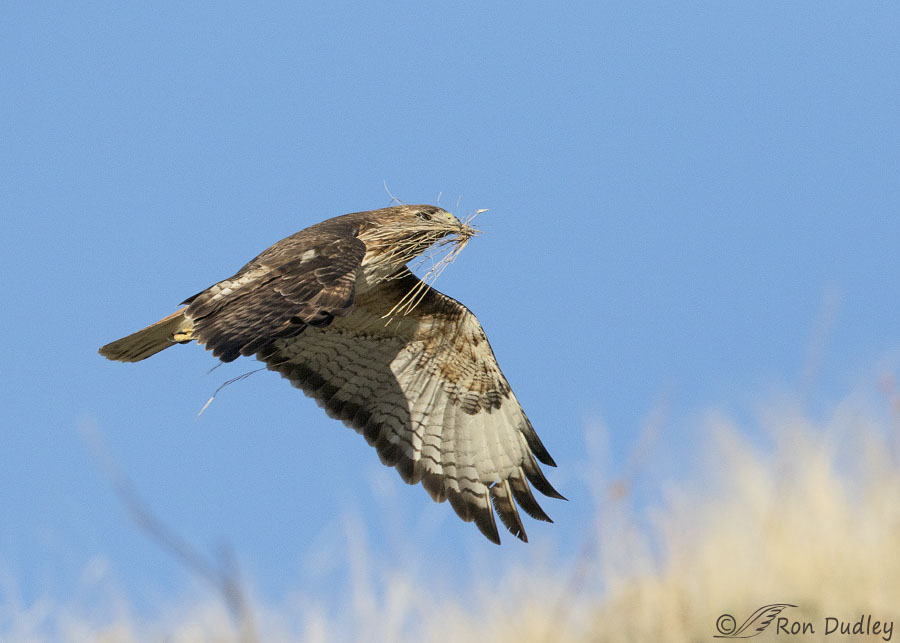
1/4000, f/7.1, ISO 640, Canon 7D Mark II, Canon EF 500mm f/4L IS II USM + EF 1.4 III Extender, not baited, set up or called in
it was just a little easier to maintain sharp focus on him.
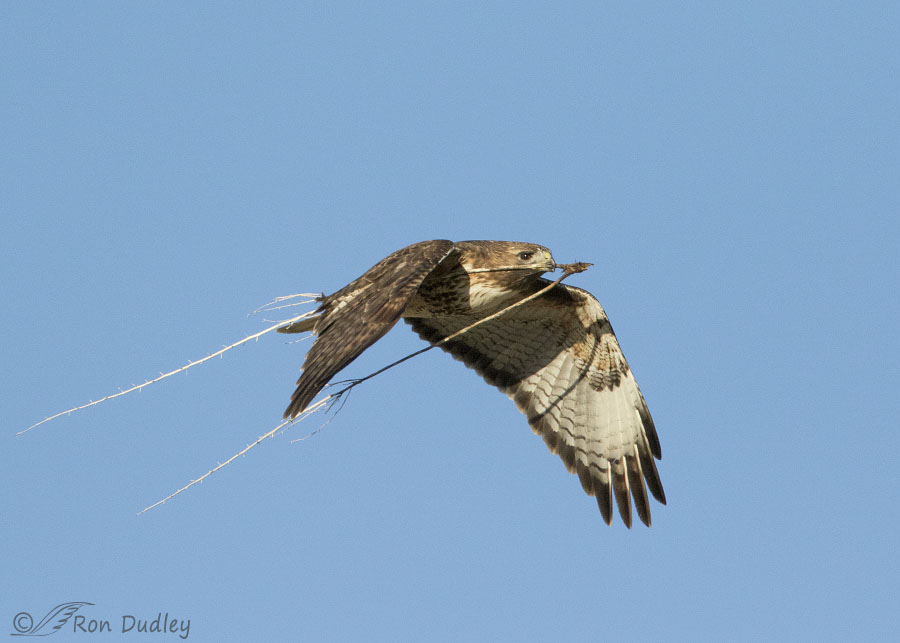
1/4000, f/7.1, ISO 640, Canon 7D Mark II, Canon EF 500mm f/4L IS II USM + EF 1.4 III Extender, not baited, set up or called in
Less than 3 minutes later he picked up a long, forked twig or branch and flew with it to the nest. The twig was so long that air resistance caused it to drag behind him and forced part of it under his right wing but that didn’t seem to interfere with his wing strokes.
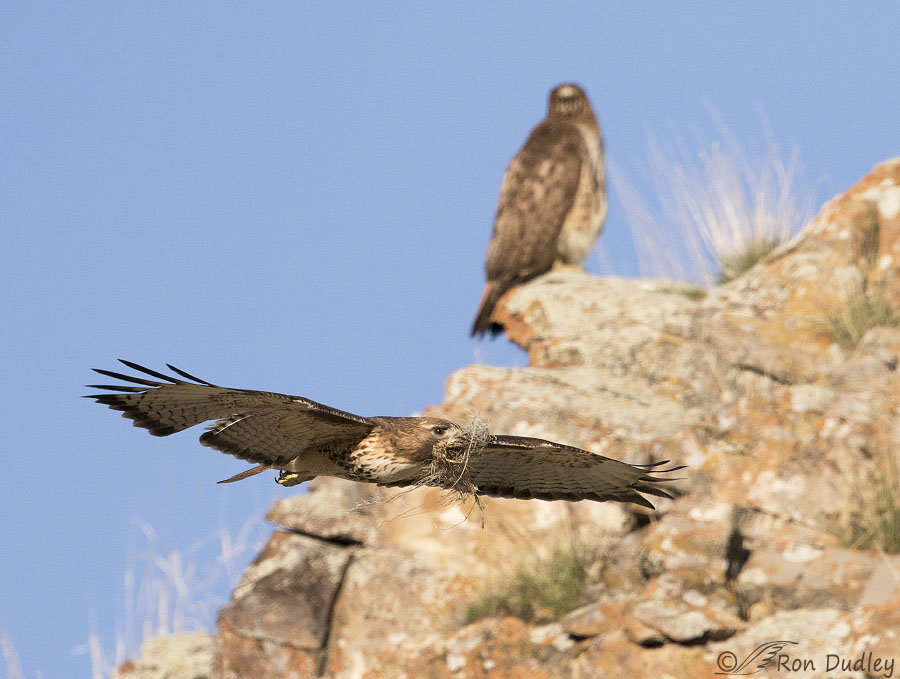
1/4000, f/7.1, ISO 640, Canon 7D Mark II, Canon EF 500mm f/4L IS II USM + EF 1.4 III Extender, not baited, set up or called in
About 11 minutes later his nesting material was a clump of finer vegetation that he probably used to line the nest.
I like this photo a lot, not because it’s perfect technically but because it’s so unusual. I happened to fire my shutter as he flew past his mate who was still on the rock they had mated on 19 minutes earlier. Because the male had to fly such a long distance to the nest from the hillside where he was gathering nesting material the chances of me getting a shot like this were extremely small.
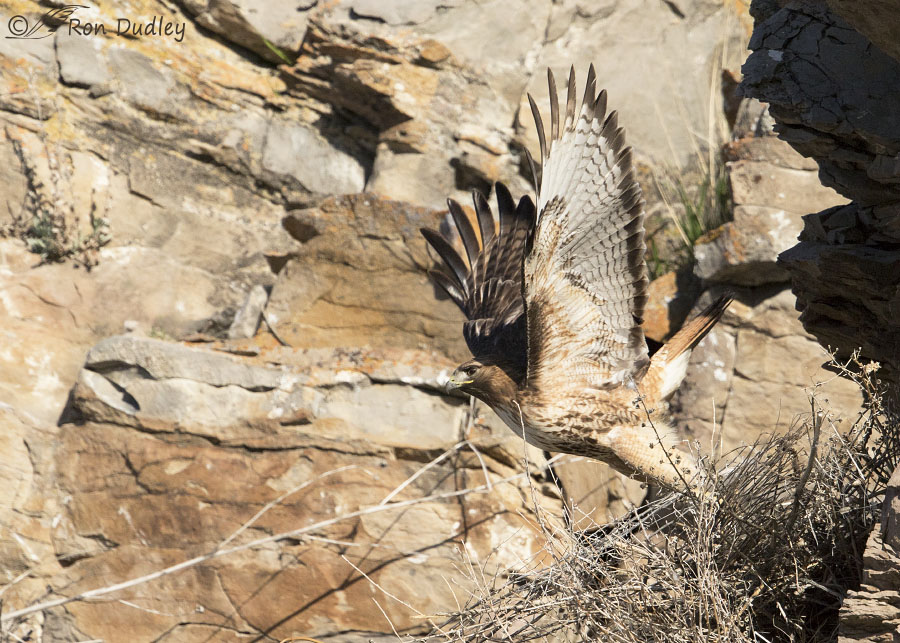
1/4000, f/7.1, ISO 640, Canon 7D Mark II, Canon EF 500mm f/4L IS II USM + EF 1.4 III Extender, not baited, set up or called in
After he delivered that latest clump of nesting material I was able to get a couple of sequential shots of him leaving the nest that I liked despite the fact that…
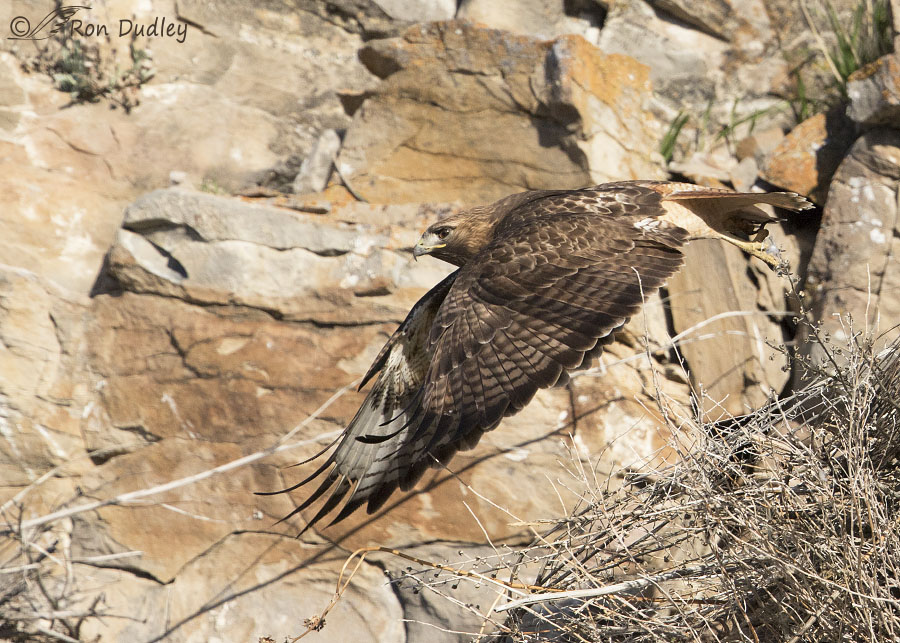
1/3200, f/7.1, ISO 640, Canon 7D Mark II, Canon EF 500mm f/4L IS II USM + EF 1.4 III Extender, not baited, set up or called in
the cliff in the background was close to the hawk and similar enough in color that he blended into the rock a little more than I prefer.
After this photo was taken he delivered one more clump of nesting material before he took an extended break and I left the area but I wasn’t particularly fond of any of those photos because he flew above the hillside so the background was homogenous blue sky.
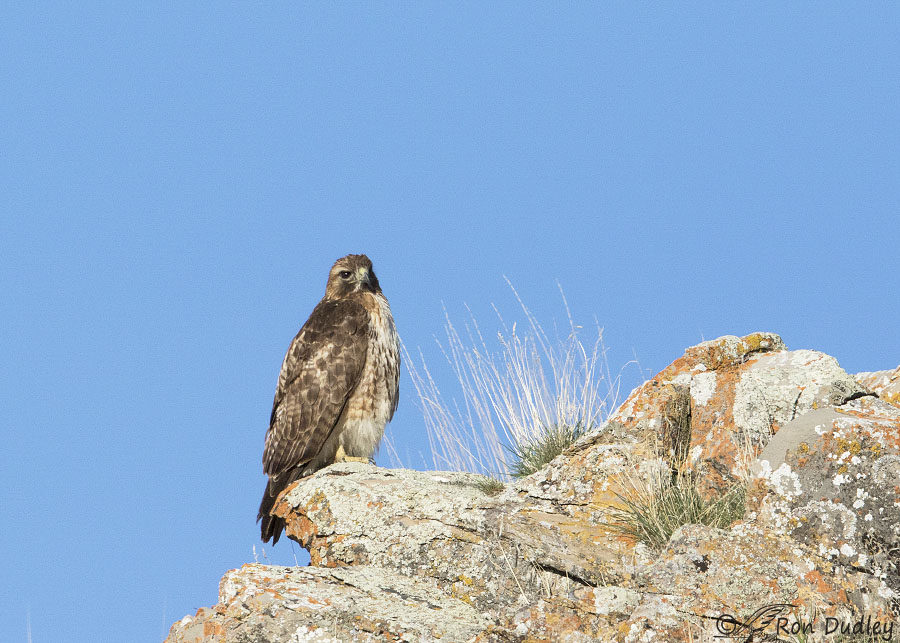
1/5000, f/7.1, ISO 640, Canon 7D Mark II, Canon EF 500mm f/4L IS II USM + EF 1.4 III Extender, not baited, set up or called in
During the entire time the male was transporting nesting material to the nest his mate remained on their “trysting rock” and almost like an overseer she seemed to supervise his efforts with a critical eye. That amused me to no end.
However I think she deserves a bit of a break before eggs are laid and incubation begins. In this species both sexes incubate but the female does the bulk of it and I can’t imagine a more boring job than sitting on those eggs for 28 – 35 days before the eggs begin to hatch.
Personally, I’d much prefer to be the male with more variety in my duties.
Ron


Love the combination of these two posts and the story that goes with them.
Ron, sure I’m too late to the party but have to comment on yesterday and today’s photos and your intriguing comments/story. What a wonderful way for me/us to see something that we might never experience in real life. Those in your posting who have “real” experiences with these beautiful and fascinating red-tailed hawks are quite lucky.
For me, you make nature come alive with your postings. I learn a great deal from you, dear Teacher.
Thank you so much, Ron
Comments are always appreciated, Alice – “late” or not. And yours was an especially thoughtful one. Thank you.
Glad he’s taking care of business after he “took care of business” 😉 I totally get that the female is hanging back — he’s busy building a nest and she’s busy making a few new birds!
These are fabulous shots and I’m so glad you gave us the rest of the story. So much fun!!!
Loved your first sentence, Marty!
I LOVE THIS.
And before I head out for a busy day I am smiling – at his confidence that the mating will be successful, and at her role as overseer.
And smiling more at the knowledgeable Laura’s comment that she won’t be satisfied and will re-arrange his work to her own liking.
Somehow I actually anticipated that you might like this post a lot, EC. Thanks.
I envy you Ron. What a fascinating way to spend a morning! It makes me miss the West and Southwest even more when I see these raptor photos.
Thanks, Skip. I could never live anywhere other than the west. I need wide open spaces. And mountains!
Honey, I want the piano over there…no, over there. . .
🙂
It always amazes me how they can weave a variety of nesting materials together, so as to construct a nest that can withstand wind and other bad weather—using only their beaks and their butts…..
Who needs thumbs, huh? LOL!
Falconer friends of mine breed goshawks, and they report the same behavior. Their older female, Desire, completely rearranges her nest three or four times before laying her eggs. She does the bulk of the rearranging overnight. She’s on her second redecorating now, so it’s almost time.
Yes, they’re extremely dexterous with their beaks.
I LOVE this series–go figure 😉
I particularly love the female supervising his efforts. I would suspect that she would soon have gone to the nest to arrange those materials to HER specifications, which are totally different from those of the male. With redtails (and raptors in general) the female definitely rules the roost. She will arrange and rearrange the sticks to her satisfaction, weaving them into a structure that is strong and impervious to most weather conditions.
And yes, the female will adjust the length of the sticks as necessary along with breaking new sticks. When they get to the nest cup, both will gather tree bark and fresh greenery. Evergreenery is preferred to repel insects, fungus and other uses (think PineSol).
Pinesol—interesting….
Love your details of nest building by Red Tailed Hawks. In my limited experience Osprey are fun to watch as the gentleman brings the materials, beak-delivering them to his mate. The lady then does most of the weaving and general construction. Proper nest construction is an art form!
Melanie, yes, I’ve watched osprey nests, too. I love ospreys…OK, I’m not real fussy with raptors, but redtails have my heart 😉
If you like, you can watch the Cornell redtail nestcam, but they’re done with the basic nest building (that’s an ongoing process until fledging). Big Red and her new beau, Arthur, are incubating three eggs, which should hatch in about a week or so. That’s an exciting time when the little fuzzball bobbleheads break out of their eggs! They’re SO cute and then they’re hawks in training in six to seven weeks. But I’ll warn you, it’s terribly addictive–in a good way, but still.
Thanks for that info, Laura. That was the question Kris Eberhard asked below so I’ve referred her to your comment.
Once again your photos are spectacular! What a wonderful series. The shot of the male’s wings in flight and and especially the way the flight feathers separate and flex as he lifts from the nest is awesome. That can only be appreciated in these still photos. I go from photo to photo saying Wow! Thank you for respecting the birds and their privacy. I wish all nature photographers had the same ethics.
Thanks very much, Melanie. I wish they would too!
Great series again Ron to follow up on your previous mating series. Great photos as always. It is remarkable the work that these birds perform to construct their nests. And so many trips back and forth often taking many days to complete. When the eagles were working on it here I had one fly right over my head one morning carrying a pretty large bunch of cattail reeds, and then on another occasion when I was hiking through a forested area near the lake I heard a very loud crack that really startled me. I looked up and there was an eagle breaking off a branch from a dead pine tree. I quickly pulled my camera up and got a shot of it flying off with the branch in its talons. Please keep providing us with these outstanding photos.
Everett Sanborn, Prescott AZ
Wow, I’ve yet to see a raptor actually breaking off a branch for its nest, Everett.
I’ve seen them rip off bark and snap off branches…almost right above my head on the Cornell campus. They’re really pretty good at it, and the Cornell couple had two favorite trees for their deciduous branches/bark. They had other favorites for evergreens, but I never located those trees. And humans? Well, to those two, humans were little more than mobile shrubbery. They seemed to enjoy buzzing the students, too.
Like they say “If momma ain’t happy”❗️ Your pictures are what I dream of to be able to see😍 I saw a scrub jay with a stick yesterday❗️
Have a great day
I’d love to photograph nesting scrub jays, Diana (from a respectful distance of course…)
Another beautiful series! Thanks.
Thanks, Joanne.
I was interested in his selection of the very long piece of material, which appeared to be a real challenge to transport…..it didn’t appear to be particularly useful in its natural state……
has anyone observed a hawk, or other bird, alter a stick– like breaking or shortening it–so it’s more useful in nest-building ?
Good question, Kris. Laura Culley (she knows her stuff when it comes to raptors) has answered it in a comment above.
What males will do for love and satisfaction! VBG!
Wonderful series Ron, great documentation.
You’re right about that, Dick! Thanks.
Cool! 🙂 Wonderful series documenting “the rest of the story”. Lot of work involved for sure!
It made me tired just watching him, Judy! Then I’d watch the female just to give myself a bit of a vicarious rest… 🙂
Wonderful behavioral series Ron! What a thrill to watch!
Charlotte
Thanks very much, Charlotte.
Very glad to see the ‘rest of the story’! Photos like this just warm my heart…there is so much to learn in observing nature in action. The actions of the male in the nest building is amazing; I’m sure you could sit for hours watching. Thanks for a great series these past two days…I felt like I was there.
Yup, I could have spent the entire morning watching these hawks, Kathy. Time very well spent!